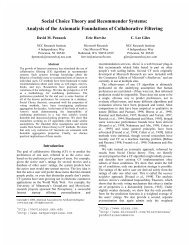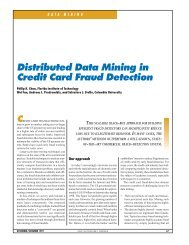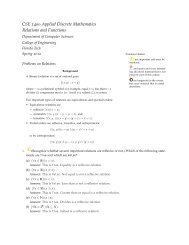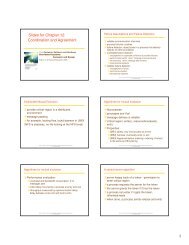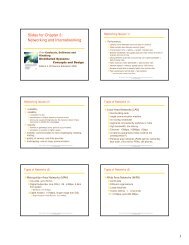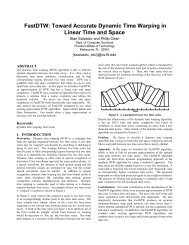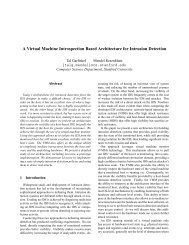Distributed objects and remote invocation
Distributed objects and remote invocation
Distributed objects and remote invocation
Create successful ePaper yourself
Turn your PDF publications into a flip-book with our unique Google optimized e-Paper software.
<strong>Distributed</strong> <strong>objects</strong> <strong>and</strong> <strong>remote</strong><br />
<strong>invocation</strong><br />
Middleware layers<br />
Applications<br />
From Coulouris, Dollimore <strong>and</strong> Kindberg<br />
<strong>Distributed</strong> Systems:<br />
Concepts <strong>and</strong> Design<br />
Edition 4, © Addison-Wesley 2005<br />
RMI, RPC <strong>and</strong> events<br />
Request reply protocol<br />
External data representation<br />
Operating System<br />
Middleware<br />
layers<br />
Instructor’s Guide for Coulouris, Dollimore <strong>and</strong> Kindberg <strong>Distributed</strong> Systems: Concepts <strong>and</strong> Design Edn. 4<br />
© Pearson Education 2005<br />
Object Communication (1):<br />
Object communication (2):<br />
<strong>Distributed</strong> <strong>objects</strong><br />
state: values of its instances variables<br />
actions: accessed only by its own methods<br />
Local: within the same process<br />
Remote: difference processes (could be on different<br />
machines)<br />
A<br />
<strong>remote</strong><br />
<strong>invocation</strong><br />
B<br />
local C<br />
<strong>invocation</strong> local E<br />
<strong>invocation</strong><br />
local<br />
<strong>invocation</strong> D<br />
<strong>remote</strong><br />
<strong>invocation</strong><br />
F<br />
Instructor’s Guide for Coulouris, Dollimore <strong>and</strong> Kindberg <strong>Distributed</strong> Systems: Concepts <strong>and</strong> Design Edn. 4<br />
© Pearson Education 2005<br />
Instructor’s Guide for Coulouris, Dollimore <strong>and</strong> Kindberg <strong>Distributed</strong> Systems: Concepts <strong>and</strong> Design Edn. 4<br />
© Pearson Education 2005<br />
Object communication (3):<br />
Remote object reference<br />
accessing the <strong>remote</strong> object<br />
identifier throughout a distributed system<br />
can be passed as arguments<br />
Object communication (4):<br />
Remote interface<br />
specifying which methods can be invoked <strong>remote</strong>ly<br />
name, arguments, return type<br />
IDL<br />
<strong>remote</strong>object<br />
Data<br />
<strong>remote</strong><br />
interface<br />
m1 implementation<br />
{ m2<br />
m3<br />
of methods<br />
m4<br />
m5<br />
m6<br />
Instructor’s Guide for Coulouris, Dollimore <strong>and</strong> Kindberg <strong>Distributed</strong> Systems: Concepts <strong>and</strong> Design Edn. 4<br />
© Pearson Education 2005<br />
Instructor’s Guide for Coulouris, Dollimore <strong>and</strong> Kindberg <strong>Distributed</strong> Systems: Concepts <strong>and</strong> Design Edn. 4<br />
© Pearson Education 2005<br />
1
Object communication (5): CORBA IDL example<br />
Object communication (6):<br />
// In file Person.idl<br />
struct Person {<br />
string name;<br />
string place;<br />
long year;<br />
} ;<br />
interface PersonList {<br />
readonly attribute string listname;<br />
void addPerson(in Person p) ;<br />
void getPerson(in string name, out Person p);<br />
long number();<br />
};<br />
Actions<br />
Needs <strong>remote</strong> object reference<br />
Calling of methods of <strong>objects</strong> in another process/host<br />
Remote <strong>objects</strong> might have methods for instantiation<br />
(hence <strong>remote</strong> instantiation)<br />
C<br />
<strong>remote</strong><br />
<strong>invocation</strong><br />
L<br />
instantiate instantiate<br />
M N<br />
<strong>remote</strong><br />
<strong>invocation</strong><br />
K<br />
Instructor’s Guide for Coulouris, Dollimore <strong>and</strong> Kindberg <strong>Distributed</strong> Systems: Concepts <strong>and</strong> Design Edn. 4<br />
© Pearson Education 2005<br />
Instructor’s Guide for Coulouris, Dollimore <strong>and</strong> Kindberg <strong>Distributed</strong> Systems: Concepts <strong>and</strong> Design Edn. 4<br />
© Pearson Education 2005<br />
Object communication (7):<br />
RMI Design Issues (1): Invocation Semantics<br />
Garbage collection<br />
local garbage collector<br />
additional module to coordinate<br />
Exceptions<br />
unexpected events or errors<br />
more <strong>and</strong> different exceptions from local methods<br />
H<strong>and</strong>ling errors<br />
retry request?<br />
duplicate filtering?<br />
retransmission of results?<br />
Semantics<br />
Maybe<br />
At least once<br />
At most once<br />
Instructor’s Guide for Coulouris, Dollimore <strong>and</strong> Kindberg <strong>Distributed</strong> Systems: Concepts <strong>and</strong> Design Edn. 4<br />
© Pearson Education 2005<br />
Instructor’s Guide for Coulouris, Dollimore <strong>and</strong> Kindberg <strong>Distributed</strong> Systems: Concepts <strong>and</strong> Design Edn. 4<br />
© Pearson Education 2005<br />
RMI Design Issues (2): Invocation semantics<br />
RMI Design Issues (3): Transparency<br />
Retransmit request<br />
message<br />
No<br />
Yes<br />
Yes<br />
Fault tolerance measures<br />
Duplicate<br />
filtering<br />
Not applicable<br />
No<br />
Yes<br />
Re-execute procedure<br />
or retransmit reply<br />
Not applicable<br />
Re-execute procedure<br />
Retransmit reply<br />
Invocation<br />
semantics<br />
Maybe<br />
At-least-once<br />
At-most-once<br />
like a local call<br />
marshalling/unmarshalling<br />
locating <strong>remote</strong> <strong>objects</strong><br />
accessing/syntax<br />
latency<br />
more likely to fail<br />
errors/exceptions: failure of the network? server?<br />
hard to tell<br />
consistency on the <strong>remote</strong> machine:<br />
Argus: incomplete transactions, abort, restore states [as if<br />
the call was never made]<br />
Instructor’s Guide for Coulouris, Dollimore <strong>and</strong> Kindberg <strong>Distributed</strong> Systems: Concepts <strong>and</strong> Design Edn. 4<br />
© Pearson Education 2005<br />
Instructor’s Guide for Coulouris, Dollimore <strong>and</strong> Kindberg <strong>Distributed</strong> Systems: Concepts <strong>and</strong> Design Edn. 4<br />
© Pearson Education 2005<br />
2
RMI Design Issues (4): Transparency<br />
RMI Implementation (1):<br />
syntax might need to be different to h<strong>and</strong>le different<br />
local vs <strong>remote</strong> errors/exceptions (e.g. Argus)<br />
affects IDL design<br />
current consensus<br />
syntax is transparent<br />
different interfaces (e.g., Java: implement Remote<br />
interface, RemoteExceptions)<br />
client<br />
server<br />
object Aproxy for B<br />
skeleton<br />
Request<br />
& dispatcher<br />
for B’s class<br />
Reply<br />
<strong>remote</strong><br />
object B<br />
servant<br />
Remote Communication Communication Remote reference<br />
reference module module module<br />
module<br />
Instructor’s Guide for Coulouris, Dollimore <strong>and</strong> Kindberg <strong>Distributed</strong> Systems: Concepts <strong>and</strong> Design Edn. 4<br />
© Pearson Education 2005<br />
Instructor’s Guide for Coulouris, Dollimore <strong>and</strong> Kindberg <strong>Distributed</strong> Systems: Concepts <strong>and</strong> Design Edn. 4<br />
© Pearson Education 2005<br />
RMI Implementation (2):<br />
Communication module<br />
request-reply: message type, requestID, <strong>remote</strong> object<br />
reference<br />
implements specific <strong>invocation</strong> semantics<br />
selects the dispatcher, passes on local reference from<br />
<strong>remote</strong> reference module, return request<br />
RMI Implementation (3):<br />
Remote reference module<br />
translating between local <strong>and</strong> <strong>remote</strong> object references<br />
<strong>remote</strong> object table<br />
⌧<strong>remote</strong> <strong>objects</strong> held by the process (B on server)<br />
⌧local proxy (B on client)<br />
<strong>remote</strong> object (first time): add to the table, create proxy<br />
Instructor’s Guide for Coulouris, Dollimore <strong>and</strong> Kindberg <strong>Distributed</strong> Systems: Concepts <strong>and</strong> Design Edn. 4<br />
© Pearson Education 2005<br />
Instructor’s Guide for Coulouris, Dollimore <strong>and</strong> Kindberg <strong>Distributed</strong> Systems: Concepts <strong>and</strong> Design Edn. 4<br />
© Pearson Education 2005<br />
RMI Implementation (4):<br />
RMI Implementation (5):<br />
RMI software<br />
Proxy: behaves like a local object, but represents the <strong>remote</strong> object<br />
Dispatcher: look at the methodID <strong>and</strong> call the corresponding method in<br />
the skeleton<br />
Skeleton: implements the method<br />
Generation of proxies, dispatchers <strong>and</strong> skeletons<br />
IDL (RMI) compiler<br />
Dynamic <strong>invocation</strong><br />
Proxies are static—interface complied into client code<br />
Dynamic—interface available during run time<br />
⌧Generic <strong>invocation</strong>; more info in “Interface Repository” (COBRA)<br />
⌧Dynamic loading of classes (Java RMI)<br />
Server initialization<br />
Server creates the first object for <strong>remote</strong> access<br />
Usually clients are not allowed to create servers<br />
Binder: locating service/object by name<br />
Table mapping for names <strong>and</strong> <strong>remote</strong> object references<br />
Server threads<br />
concurrency<br />
Instructor’s Guide for Coulouris, Dollimore <strong>and</strong> Kindberg <strong>Distributed</strong> Systems: Concepts <strong>and</strong> Design Edn. 4<br />
© Pearson Education 2005<br />
Instructor’s Guide for Coulouris, Dollimore <strong>and</strong> Kindberg <strong>Distributed</strong> Systems: Concepts <strong>and</strong> Design Edn. 4<br />
© Pearson Education 2005<br />
3
RMI Implementation (6):<br />
activation of <strong>remote</strong> <strong>objects</strong><br />
many server <strong>objects</strong>, all running?<br />
active <strong>and</strong> passive status<br />
⌧active: available for <strong>invocation</strong> in a running process<br />
⌧passive: not running, state is stored on disk<br />
Activation<br />
⌧create an active object from a passive object<br />
⌧register the new active object<br />
Java RMI—<strong>objects</strong> can be activatable<br />
similar to inetd<br />
RMI Implementation (7):<br />
persistent object stores<br />
stored in marshaled from on disk for retrieval<br />
saved those that were modified<br />
persistent or not:<br />
⌧persistent root: any descendent <strong>objects</strong> (reachable from the root) are<br />
persistent (eg. persistent Java, PerDiS)<br />
⌧certain classes are declared persistent (eg. Arjuna system)<br />
Instructor’s Guide for Coulouris, Dollimore <strong>and</strong> Kindberg <strong>Distributed</strong> Systems: Concepts <strong>and</strong> Design Edn. 4<br />
© Pearson Education 2005<br />
Instructor’s Guide for Coulouris, Dollimore <strong>and</strong> Kindberg <strong>Distributed</strong> Systems: Concepts <strong>and</strong> Design Edn. 4<br />
© Pearson Education 2005<br />
RMI Implementation (8):<br />
RMI Implementation (9): <strong>Distributed</strong> garbage collection<br />
Object location<br />
ip address, port #, …<br />
location service for migratable <strong>objects</strong><br />
⌧map <strong>remote</strong> object references to their probable current locations<br />
(Clouds <strong>and</strong> Emerald systems)<br />
⌧Cache/broadcast scheme (similar to ARP)<br />
• Cache locations<br />
• If not in cache, broadcast to find it<br />
⌧Improvement: forwarding (similar to mobile IP)<br />
Reference count<br />
Java's approach<br />
the server of an object (B) keeps track of proxies<br />
addRef(B) is called when a proxy is created for a <strong>remote</strong> object<br />
addRef(B) tells the server to add an entry<br />
when the local host's garbage collector removes the proxy<br />
removeRef(B) tells the server to remove the entry<br />
when no entries for object B, the object on server is deallocated<br />
Race condition<br />
removeRef(B) from client X<br />
addRef(B) from client Y<br />
Communication failures<br />
addRef() didn't return successfully<br />
removeRef() will be issued<br />
Client process failures<br />
leases from server<br />
renew before expiration<br />
entry removed if not renewed before expiration<br />
Instructor’s Guide for Coulouris, Dollimore <strong>and</strong> Kindberg <strong>Distributed</strong> Systems: Concepts <strong>and</strong> Design Edn. 4<br />
© Pearson Education 2005<br />
Instructor’s Guide for Coulouris, Dollimore <strong>and</strong> Kindberg <strong>Distributed</strong> Systems: Concepts <strong>and</strong> Design Edn. 4<br />
© Pearson Education 2005<br />
Remote Procedure Call (1):<br />
Remote Procedure Call (2)<br />
at-least-once or at-most-once semantics<br />
client: "stub" instead of "proxy" (same function,<br />
different names)<br />
local call, marshal arguments, communicate the request<br />
server:<br />
dispatcher<br />
"stub": unmarshall arguments, communicate the results<br />
back<br />
client process<br />
server process<br />
Request<br />
Reply<br />
client stub<br />
server stub<br />
procedure<br />
procedure<br />
client<br />
program Communication Communication<br />
module module dispatcher<br />
service<br />
procedure<br />
Instructor’s Guide for Coulouris, Dollimore <strong>and</strong> Kindberg <strong>Distributed</strong> Systems: Concepts <strong>and</strong> Design Edn. 4<br />
© Pearson Education 2005<br />
Instructor’s Guide for Coulouris, Dollimore <strong>and</strong> Kindberg <strong>Distributed</strong> Systems: Concepts <strong>and</strong> Design Edn. 4<br />
© Pearson Education 2005<br />
4
Sun RPC (1):<br />
Sun RPC (2): Sun XDR<br />
Client-server comm in the SUN NFS (network file system)<br />
Also called ONC (Open Network Computing) RPC<br />
In other unix OS as well<br />
UDP or TCP<br />
Interface Definition Language (IDL)<br />
initially XDR is for data representation, extended to be IDL<br />
less modern than CORBA IDL <strong>and</strong> Java<br />
⌧program numbers instead of interface names<br />
⌧procedure numbers instead of procedure names<br />
⌧single input parameter (structs)<br />
rpcgen: compiler for XDR<br />
client stub<br />
server main procedure, dispatcher, <strong>and</strong> server stub<br />
XDR marshalling, unmarshaling<br />
const MAX = 1000;<br />
typedef int FileIdentifier;<br />
typedef int FilePointer;<br />
typedef int Length;<br />
struct Data {<br />
int length;<br />
char buffer[MAX];<br />
};<br />
struct writeargs {<br />
FileIdentifier f;<br />
FilePointer position;<br />
Data data;<br />
};<br />
struct readargs {<br />
FileIdentifier f;<br />
FilePointer position;<br />
Length length;<br />
};<br />
program FILEREADWRITE {<br />
version VERSION {<br />
void WRITE(writeargs)=1; 1<br />
Data READ(readargs)=2; 2<br />
}=2;<br />
} = 9999;<br />
Instructor’s Guide for Coulouris, Dollimore <strong>and</strong> Kindberg <strong>Distributed</strong> Systems: Concepts <strong>and</strong> Design Edn. 4<br />
© Pearson Education 2005<br />
Instructor’s Guide for Coulouris, Dollimore <strong>and</strong> Kindberg <strong>Distributed</strong> Systems: Concepts <strong>and</strong> Design Edn. 4<br />
© Pearson Education 2005<br />
Sun RPC (3):<br />
Java RMI (1): Remote interface ShapeList<br />
binding (registry)<br />
local binder--portmapper<br />
server registers its program/version/port numbers with<br />
portmapper<br />
client contacts the portmapper at a fixed port with<br />
program/version numbers to get the server port<br />
different instances of the same service can be run on<br />
different computers--different ports<br />
authentication<br />
request <strong>and</strong> reply have additional fields<br />
unix style (uid, gid), shared key for signing, Kerberos<br />
import java.rmi.*;<br />
import java.util.Vector;<br />
public interface Shape extends Remote {<br />
int getVersion() throws RemoteException;<br />
GraphicalObject getAllState() throws RemoteException; 1<br />
}<br />
public interface ShapeList extends Remote {<br />
Shape newShape(GraphicalObject g) throws RemoteException; 2<br />
Vector allShapes() throws RemoteException;<br />
int getVersion() throws RemoteException;<br />
}<br />
Instructor’s Guide for Coulouris, Dollimore <strong>and</strong> Kindberg <strong>Distributed</strong> Systems: Concepts <strong>and</strong> Design Edn. 4<br />
© Pearson Education 2005<br />
Instructor’s Guide for Coulouris, Dollimore <strong>and</strong> Kindberg <strong>Distributed</strong> Systems: Concepts <strong>and</strong> Design Edn. 4<br />
© Pearson Education 2005<br />
Java RMI (2): ShapeListServant implements<br />
interface ShapeList<br />
Java RMI (3): Server main method<br />
import java.rmi.*;<br />
import java.rmi.server.UnicastRemoteObject;<br />
import java.util.Vector;<br />
public class ShapeListServant extends UnicastRemoteObject implements ShapeList {<br />
private Vector theList; // contains the list of Shapes 1<br />
private int version;<br />
public ShapeListServant()throws RemoteException{...}<br />
public Shape newShape(GraphicalObject g) throws RemoteException { 2<br />
version++;<br />
Shape s = new ShapeServant(g, version); 3<br />
theList.addElement(s);<br />
return s;<br />
}<br />
public Vector allShapes()throws RemoteException{...}<br />
public int getVersion() throws RemoteException { ... }<br />
}<br />
import java.rmi.*;<br />
public class ShapeListServer{<br />
public static void main(String args[]){<br />
System.setSecurityManager(new RMISecurityManager());<br />
try{<br />
ShapeList aShapeList = new ShapeListServant(); 1<br />
Naming.rebind("Shape List", aShapeList ); 2<br />
System.out.println("ShapeList server ready");<br />
}catch(Exception e) {<br />
System.out.println("ShapeList server main " + e.getMessage());}<br />
}<br />
}<br />
Instructor’s Guide for Coulouris, Dollimore <strong>and</strong> Kindberg <strong>Distributed</strong> Systems: Concepts <strong>and</strong> Design Edn. 4<br />
© Pearson Education 2005<br />
Instructor’s Guide for Coulouris, Dollimore <strong>and</strong> Kindberg <strong>Distributed</strong> Systems: Concepts <strong>and</strong> Design Edn. 4<br />
© Pearson Education 2005<br />
5
Java RMI (4): client of ShapeList<br />
Java RMI (5): Java RMIregistry (port 1099)<br />
import java.rmi.*;<br />
import java.rmi.server.*;<br />
import java.util.Vector;<br />
public class ShapeListClient{<br />
public static void main(String args[]){<br />
System.setSecurityManager(new RMISecurityManager());<br />
ShapeList aShapeList = null;<br />
try{<br />
aShapeList = (ShapeList) Naming.lookup("//bruno.ShapeList") ; 1<br />
Vector sList = aShapeList.allShapes(); 2<br />
} catch(RemoteException e) {System.out.println(e.getMessage());<br />
}catch(Exception e) {System.out.println("Client: " + e.getMessage());}<br />
}<br />
}<br />
void rebind (String name, Remote obj)<br />
This method is used by a server to register the identifier of a <strong>remote</strong> object by<br />
name, as shown in Figure 15.13, line 3.<br />
void bind (String name, Remote obj)<br />
This method can alternatively be used by a server to register a <strong>remote</strong> object<br />
by name, but if the name is already bound to a <strong>remote</strong> object reference an<br />
exception is thrown.<br />
void unbind (String name, Remote obj)<br />
This method removes a binding.<br />
Remote lookup(String name)<br />
This method is used by clients to look up a <strong>remote</strong> object by name, as shown<br />
in Figure 15.15 line 1. A <strong>remote</strong> object reference is returned.<br />
String [] list()<br />
This method returns an array of Strings containing the names bound in the<br />
registry.<br />
Instructor’s Guide for Coulouris, Dollimore <strong>and</strong> Kindberg <strong>Distributed</strong> Systems: Concepts <strong>and</strong> Design Edn. 4<br />
© Pearson Education 2005<br />
Instructor’s Guide for Coulouris, Dollimore <strong>and</strong> Kindberg <strong>Distributed</strong> Systems: Concepts <strong>and</strong> Design Edn. 4<br />
© Pearson Education 2005<br />
Java RMI (6):<br />
Events <strong>and</strong> notifications (1):<br />
Callbacks<br />
server notifying the clients of events<br />
⌧Initiated by server [opposite to initiated by client]<br />
why?<br />
⌧polling from clients increases overhead on server<br />
⌧not up-to-date for clients to inform users<br />
how<br />
⌧<strong>remote</strong> object (callback object) on client for server to call<br />
⌧client tells the server about the callback object, server put the client on a<br />
list<br />
⌧server call methods on the callback object when events occur<br />
client might forget to remove itself from the list<br />
⌧lease--client expire<br />
events of changes/updates...<br />
notifications of events to parties interested in the events<br />
publish events to send<br />
subscribe events to receive<br />
main characteristics in distributed event-based systems:<br />
a way to st<strong>and</strong>ardize communication in heterogeneous systems (not<br />
designed to communicate directly)<br />
asynchronous communication (no need for a publisher to wait for each<br />
subscriber--subscribers come <strong>and</strong> go)<br />
event types<br />
each type has attributes (information in it)<br />
subscription filtering: focus on certain values in the attributes (e.g.<br />
"buy" events, but only "buy car" events)<br />
Instructor’s Guide for Coulouris, Dollimore <strong>and</strong> Kindberg <strong>Distributed</strong> Systems: Concepts <strong>and</strong> Design Edn. 4<br />
© Pearson Education 2005<br />
Instructor’s Guide for Coulouris, Dollimore <strong>and</strong> Kindberg <strong>Distributed</strong> Systems: Concepts <strong>and</strong> Design Edn. 4<br />
© Pearson Education 2005<br />
Events <strong>and</strong> Notifications (2): [subscribers: dealers in<br />
stock exchange]<br />
Events <strong>and</strong> notifications (3):<br />
Dealer’s computer<br />
Dealer<br />
Dealer’s computer<br />
Dealer<br />
Notification<br />
Notification<br />
Notification<br />
Notification<br />
Notification<br />
Information<br />
provider<br />
External<br />
source<br />
Information<br />
provider<br />
External<br />
source<br />
Notification<br />
Notification<br />
Notification<br />
Notification<br />
Notification<br />
Dealer’s computer<br />
Dealer<br />
Dealer’s computer<br />
Dealer<br />
<strong>Distributed</strong> event notification<br />
decouple publishers from subscribers via an event service (manager)<br />
Architecture:<br />
object of interest (usually changes in states, e.g. temperature, price)<br />
event<br />
notification<br />
subscriber<br />
observer object (proxy) [reduce work on the object of interest]<br />
⌧forwarding<br />
⌧filtering of events types <strong>and</strong> content/attributes<br />
⌧patterns of events (occurrence of multiple events, not just one) [e.g. drop in<br />
temperature for more than five degrees three times in a row]<br />
⌧mailboxes (notifications in batches, subscriber might not be ready)<br />
publisher (object of interest or observer object)<br />
⌧generates event notifications<br />
Instructor’s Guide for Coulouris, Dollimore <strong>and</strong> Kindberg <strong>Distributed</strong> Systems: Concepts <strong>and</strong> Design Edn. 4<br />
© Pearson Education 2005<br />
Instructor’s Guide for Coulouris, Dollimore <strong>and</strong> Kindberg <strong>Distributed</strong> Systems: Concepts <strong>and</strong> Design Edn. 4<br />
© Pearson Education 2005<br />
6
Events <strong>and</strong> Notifications (4):<br />
Events <strong>and</strong> Notifications (5)<br />
Event service<br />
object of interest<br />
1.<br />
object of interest observer<br />
2. notification<br />
notification<br />
notification<br />
subscriber<br />
subscriber<br />
Jini<br />
event generators (publishers)<br />
<strong>remote</strong> event listeners (subscribers)<br />
<strong>remote</strong> events (events)<br />
third-party agents (observers)<br />
object of interest<br />
observer<br />
subscriber<br />
3.<br />
notification<br />
[3: observer checks for changes; object of interest is not part of the event service]<br />
Instructor’s Guide for Coulouris, Dollimore <strong>and</strong> Kindberg <strong>Distributed</strong> Systems: Concepts <strong>and</strong> Design Edn. 4<br />
© Pearson Education 2005<br />
Instructor’s Guide for Coulouris, Dollimore <strong>and</strong> Kindberg <strong>Distributed</strong> Systems: Concepts <strong>and</strong> Design Edn. 4<br />
© Pearson Education 2005<br />
7


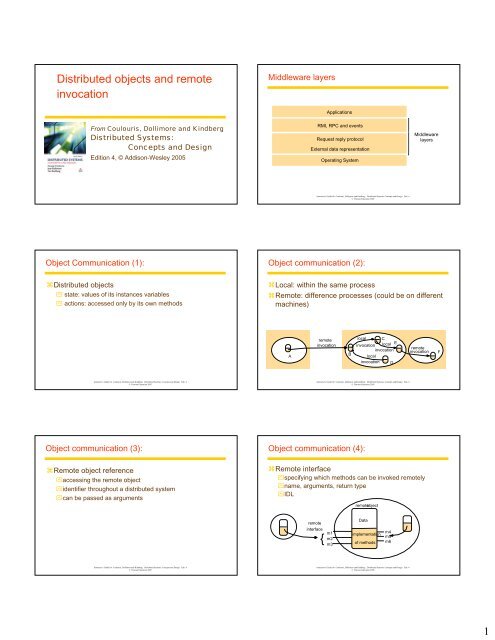
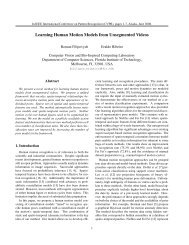
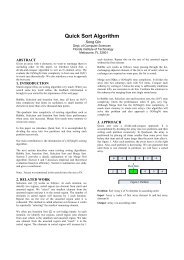
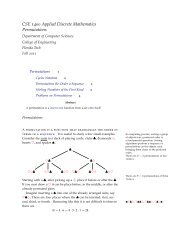
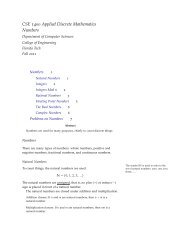
![{ public static void main (String[] args) { System.out.println (](https://img.yumpu.com/49719541/1/190x143/-public-static-void-main-string-args-systemoutprintln-hello-.jpg?quality=85)
